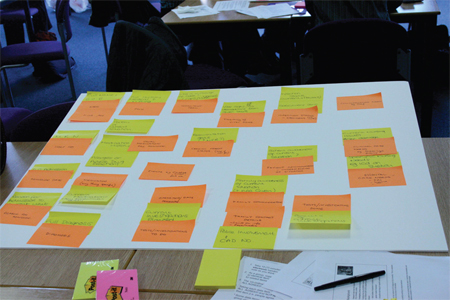7.1: Data gathering for the Safer Handover project
Julia Galliers and Stephanie Wilson, CHCID, City University London, UK
Overview
The Safer Handover project was initiated by the UK's NHS Connecting for Health. They wanted to know whether there is a 'common core data set' for clinical handover, i.e. a set of data items that health professionals need to know at every transfer of patient care. Transfers in care happen when a patient is moved from one healthcare setting to another (e.g. home to hospital, ambulance to emergency department, one department in a hospital to another), and whenever there is a shift change. The vision was that these essential data items would ultimately be embedded through a forcing function into future electronic handover technologies as part of
There were two major challenges. Firstly, each type of handover is very different (nine types were identifi ed: e.g. medical shift change). Secondly, even data sets for the same type of handover vary wildly between healthcare settings, not only in terms of the data items, but also the particular terminology used as well as the level of detail. In practice, each setting evolves 'the way we do it here.' It was decided to approach the problem from several different angles and see what (if any) consensus could be found.
Firstly, data was collected via a thorough literature search. More than 60 different standardized protocols and minimum data sets were compared. Secondly, a workshop was held for 36 experts from a wide variety of healthcare settings with experience of all the different types of handover.
A number of data collection activities took place at the workshop. The fi rst of these aimed to fi nd a minimum data set for each of the different types of handover. The method involved participants of mixed professional roles and experience forming a group for each handover type. Each group member wrote the data items they considered essential for that type of handover onto sticky notes. The group then merged these into an affi nity diagram from which they created an AGREED and a NOT AGREED list on a fl ipchart. The AGREED list comprised data items suggested by all group members and the NOT AGREED list showed a 'weighting' for each item, i.e. how many people deemed this item essential. This was repeated twice with different groupings for each type of handover, the fi nal group also rationalizing the results of the previous two groups. The second activity was a controlled negotiation/group discussion aimed at determining an agreed core data set from the fi nal collection of fl ipcharts. The last activity involved each individual participant imagining they were only allowed to handover four data items. They wrote these on a sticky note, in silence.

The results of the workshop exercises and literature survey confirmed a huge variation
in the data items and terminology used. Those data items that appeared most frequently in
all the different data gathering activities were used in a validation questionnaire which was
sent out to workshop participants and other colleagues. In addition, in order to overcome the
problems encountered with precise terms, we raised the level of granularity and included a set
of questions, such as: 'Who is this patient?' 'What is wrong with them?' 'What has been done?'
'What needs to be done?,' and so on, which the majority of respondents liked. Ultimately, we
recommended a core data set that comprised a mix of both questions and example data items.
We hope this will be taken forward in further work on data standards for clinical handover
and that it will form the basis for a core data set to be embedded as standard into the design
of future electronic handover technologies.
This case study (on the website), which was conducted by a team led by Julia Galliers and Stephanie Wilson of the Centre for HCI Design, City University, London, looks in more detail at the approach to data gathering and how different techniques were combined to suit the specific circumstances of the project.
View Case Study